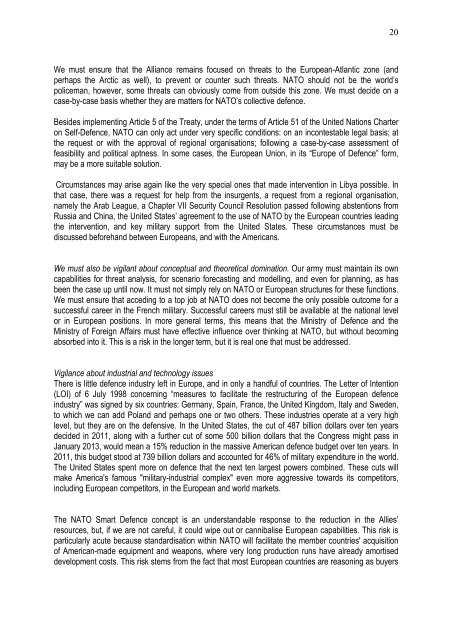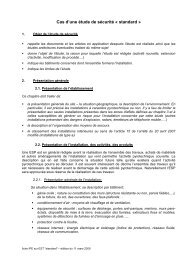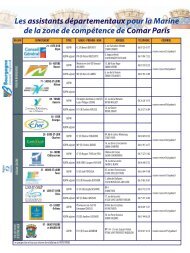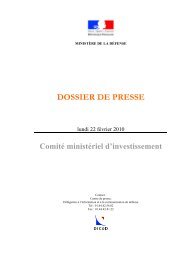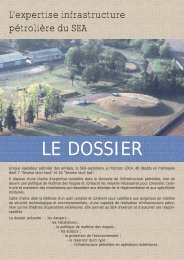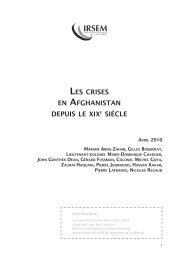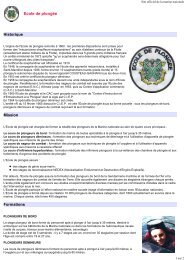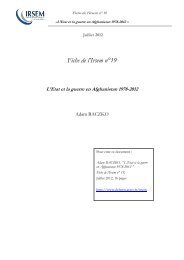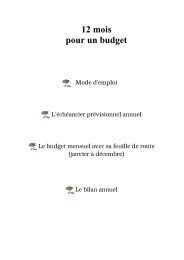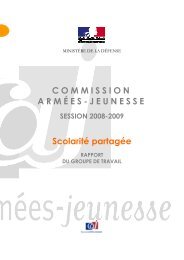Rapport Védrine_ENG_GERMAN - Ministère de la Défense
Rapport Védrine_ENG_GERMAN - Ministère de la Défense
Rapport Védrine_ENG_GERMAN - Ministère de la Défense
Sie wollen auch ein ePaper? Erhöhen Sie die Reichweite Ihrer Titel.
YUMPU macht aus Druck-PDFs automatisch weboptimierte ePaper, die Google liebt.
We must ensure that the Alliance remains focused on threats to the European-At<strong>la</strong>ntic zone (and<br />
perhaps the Arctic as well), to prevent or counter such threats. NATO should not be the world’s<br />
policeman, however, some threats can obviously come from outsi<strong>de</strong> this zone. We must <strong>de</strong>ci<strong>de</strong> on a<br />
case-by-case basis whether they are matters for NATO’s collective <strong>de</strong>fence.<br />
Besi<strong>de</strong>s implementing Article 5 of the Treaty, un<strong>de</strong>r the terms of Article 51 of the United Nations Charter<br />
on Self-Defence, NATO can only act un<strong>de</strong>r very specific conditions: on an incontestable legal basis; at<br />
the request or with the approval of regional organisations; following a case-by-case assessment of<br />
feasibility and political aptness. In some cases, the European Union, in its “Europe of Defence” form,<br />
may be a more suitable solution.<br />
Circumstances may arise again like the very special ones that ma<strong>de</strong> intervention in Libya possible. In<br />
that case, there was a request for help from the insurgents, a request from a regional organisation,<br />
namely the Arab League, a Chapter VII Security Council Resolution passed following abstentions from<br />
Russia and China, the United States’ agreement to the use of NATO by the European countries leading<br />
the intervention, and key military support from the United States. These circumstances must be<br />
discussed beforehand between Europeans, and with the Americans.<br />
We must also be vigi<strong>la</strong>nt about conceptual and theoretical domination. Our army must maintain its own<br />
capabilities for threat analysis, for scenario forecasting and mo<strong>de</strong>lling, and even for p<strong>la</strong>nning, as has<br />
been the case up until now. It must not simply rely on NATO or European structures for these functions.<br />
We must ensure that acceding to a top job at NATO does not become the only possible outcome for a<br />
successful career in the French military. Successful careers must still be avai<strong>la</strong>ble at the national level<br />
or in European positions. In more general terms, this means that the Ministry of Defence and the<br />
Ministry of Foreign Affairs must have effective influence over thinking at NATO, but without becoming<br />
absorbed into it. This is a risk in the longer term, but it is real one that must be addressed.<br />
Vigi<strong>la</strong>nce about industrial and technology issues<br />
There is little <strong>de</strong>fence industry left in Europe, and in only a handful of countries. The Letter of Intention<br />
(LOI) of 6 July 1998 concerning “measures to facilitate the restructuring of the European <strong>de</strong>fence<br />
industry” was signed by six countries: Germany, Spain, France, the United Kingdom, Italy and Swe<strong>de</strong>n,<br />
to which we can add Po<strong>la</strong>nd and perhaps one or two others. These industries operate at a very high<br />
level, but they are on the <strong>de</strong>fensive. In the United States, the cut of 487 billion dol<strong>la</strong>rs over ten years<br />
<strong>de</strong>ci<strong>de</strong>d in 2011, along with a further cut of some 500 billion dol<strong>la</strong>rs that the Congress might pass in<br />
January 2013, would mean a 15% reduction in the massive American <strong>de</strong>fence budget over ten years. In<br />
2011, this budget stood at 739 billion dol<strong>la</strong>rs and accounted for 46% of military expenditure in the world.<br />
The United States spent more on <strong>de</strong>fence that the next ten <strong>la</strong>rgest powers combined. These cuts will<br />
make America's famous "military-industrial complex" even more aggressive towards its competitors,<br />
including European competitors, in the European and world markets.<br />
The NATO Smart Defence concept is an un<strong>de</strong>rstandable response to the reduction in the Allies’<br />
resources, but, if we are not careful, it could wipe out or cannibalise European capabilities. This risk is<br />
particu<strong>la</strong>rly acute because standardisation within NATO will facilitate the member countries' acquisition<br />
of American-ma<strong>de</strong> equipment and weapons, where very long production runs have already amortised<br />
<strong>de</strong>velopment costs. This risk stems from the fact that most European countries are reasoning as buyers<br />
20


